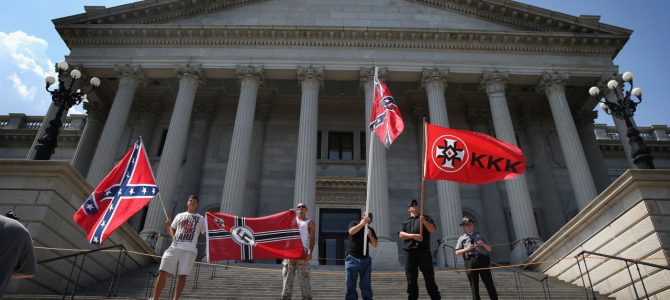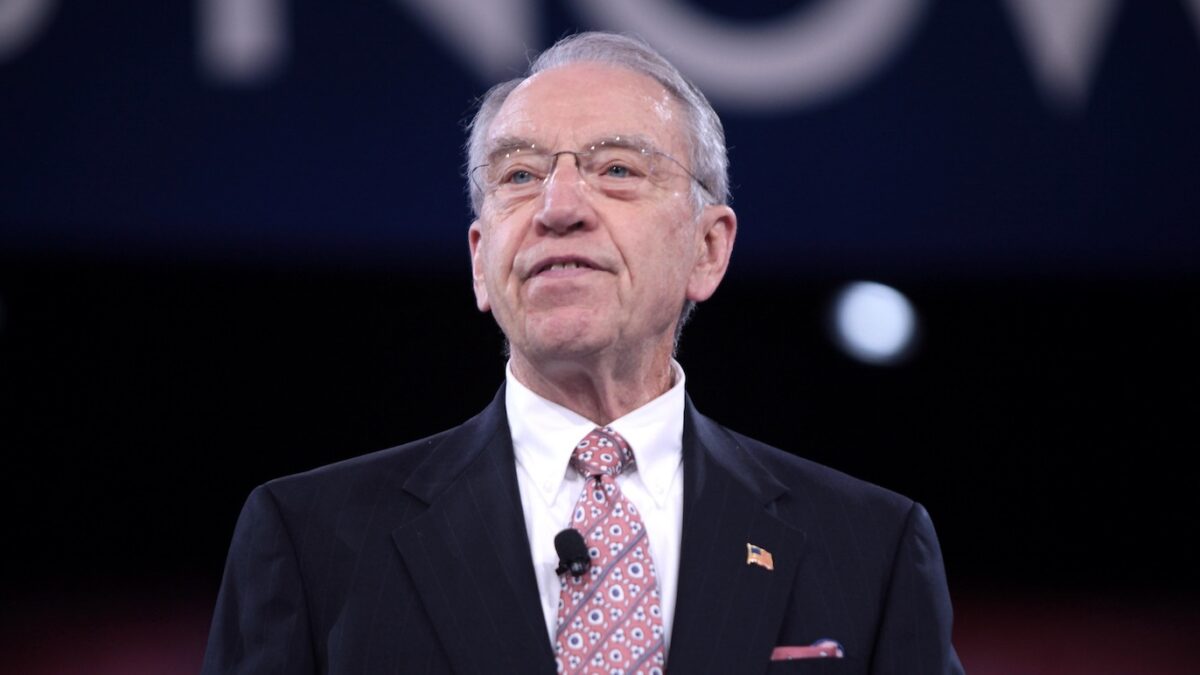
What makes the hate list of the Southern Poverty Law Center different from the “burn book” a high school queen bee keeps in the 2004 movie “Mean Girls”? Answer: not much. The burn book was a compilation of insults, gossip, and rumors intended to repel the diva’s “enemies,” label everybody, and keep herself on top of the heap.
The SPLC uses its list of designated hate groups in much the same way: to manipulate the lives of others, smear reputations, control personal relationships, and reap the spoils. The dynamic is the same, whether played on the adolescent scene or in the political arena. Both lists serve mostly as power-mongering tools.
In civilized societies, we supposedly grow out of that sort of tribalism. But look around and you’ll see such behaviors proliferating in every sphere: politics, journalism, education. A recent headline in the Washington Examiner nailed it: “The Bret Stephens Freak Out is a Reminder that the Media Is Basically a Massive High School Clique.”
Why do so many folks treat the SPLC with undeserved reverence, the way too many high school kids treat a self-appointed nasty queen bee? Why do they accept the Southern Poverty Law Center as the nation’s Grand Inquisitor dictating who may speak and who must shut up? And why are its smears and caricatures so often blindly accepted at face value? What qualifies the SPLC to act as judge, jury, and social executioner of any human being who is not their blind supporter?
Those questions have been hanging in the air for decades. As with all vilification campaigns, the SPLC plays a dangerous and cruel game under the guise of defending victims. So let’s take a closer look at some of the SPLC’s history and behavior. Let’s count some ways it’s a con game.
1. It’s a Big-Money Smear Machine
The SPLC’s main role is as a massively funded propaganda smear machine. The following information on the SPLC, provided by Karl Zinsmeister of Philanthropy Roundtable, is an eye-opener: “Its two largest expenses are propaganda operations: creating its annual lists of ‘haters’ and ‘extremists,’ and running a big effort that pushes ‘tolerance education’ through more than 400,000 public-school teachers. And the single biggest effort undertaken by the SPLC? Fundraising. On the organization’s 2015 IRS 990 form it declared $10 million of direct fundraising expenses, far more than it has ever spent on legal services.”
2. The Center’s Work Has Incited Violence
The SPLC’s agitation and propaganda have proven to incite violence. Any person or organization of note who doesn’t get with the SPLC’s political agendas—whether they promote family integrity, religious freedom, U.S. immigration law, or anything else—is liable to end up smeared as an SPLC-certified agent of hate.
The SPLC website keeps tabs on designated bad guys with a Hate Map of the United States and an invitation for readers to #reporthate. The SPLC’s hate list includes the Family Research Council in Washington DC, and the 2012 shooting at FRC headquarters was inspired through the influence of SPLC agitprop, according to the gunman himself. He would have committed mass murder if he wasn’t stopped.
The recent mob violence in response to social scientist Charles Murray’s talk at Middlebury College, and the assault of a faculty member there, were products of the SPLC’s smear of Murray as an “extremist.” The list goes on.
3. SLPC Uses Emotion-Laden Images to Spread Innuendo
SPLC uses emotion-laden images with nary any evidence to “spread stigma just by innuendo.” Zinsmeister from Philanthropy Roundtable notes: “Over the years, numerous investigators have pointed out that most of the scary KKK and Nazi and militia groups that the SPLC insists are lurking under our beds are actually ghost entities, with no employees, no address, hardly any followers, and little or no footprint.”
But “hate groups” and “extremist organizations” are great copy, especially for fundraising. So the SPLC list of storm-troopers-in-our-midst is catnip for journalists looking for dramatic stories. SPLC’s lack of reasonable criteria for who goes on its list of crazies combines effortlessly with careless reporting, and spreads stigma just by innuendo. Mere proximity to SPLC’s arbitrary “hate” list is enough to tar even the worthiest group.
4. The FBI Stopped Citing SPLC as a Resource
Two years ago, the FBI deleted the SPLC from its website’s list of legitimate resources on hate crimes. This is a promising sign of growing clarity that the SPLC’s designations for hate groups lack legitimacy. There also seems to be growing boldness in calling out the SPLC for its tactics intended to shut down serious scholarship.
5. People On Its Political Team See the Problems, Too
Even some self-identified progressives are taking issue with SPLC vilification campaigns after the 2012 SPLC-inspired shooting at the Family Research Council. The SPLC’s emotionally charged rhetoric ignites divisions among people rather than healing anything. And there’s no telling where that can end up. So even leftist Washington Post columnist Dana Milbank wrote that the SPLC’s labeling of the Family Research Center as a hate group was a reckless act.
6. Its Nonprofit Status Masks Highly Political Fundraising
The SPLC operates far more as a political action committee than as the nonprofit it claims to be. The hyper-partisan nature of the SPLC’s operations makes its nonprofit status seem like a joke. In a recent letter to Treasury Secretary Steven Mnuchin, the Federation for Immigration Reform argued that the SPLC’s tax-exempt 501(c)3 status should be revoked because in the 2016 elections, the SPLC clearly violated the Internal Revenue Service requirement that prohibits “participating in or intervening (including the publishing or distributing of statements), in any political campaign on behalf of (or in opposition to) any candidate for elective public office.”
7. Its Public Activities Are a Ruse for Fundraising
The SPLC is little more than a “cash collecting machine” rooted more deeply in fund-raising opportunism than in any do-gooder impulse. The SPLC was founded in 1971, after much of the heroic heavy lifting of the civil rights era was already over and the Ku Klux Klan was pretty much beyond its death throes. But invoking the imagery of pointy white hoods still seems to be an irresistible fund-raising ploy for the SPLC.
Again, Zinsmeister at Philanthropy Roundtable calls it out: “The SPLC is a cash-collecting machine. In 2015 it vacuumed up $50 million in contributions and foundation grants, a tidy addition to its $334 million holdings of cash and securities and its headquarters worth $34 million. ‘They’ve never spent more than 31 percent of the money they were bringing in on programs, and sometimes they spent as little as 18 percent. Most nonprofits spend about 75 percent on programs,’ noted Jim Tharpe, managing editor of the SPLC’s hometown newspaper, the Montgomery Advertiser, in a talk at Harvard’s Nieman Foundation for Journalism.”
Zinsmeister adds: “Though it styles itself as a public-interest law firm, the Southern Poverty Law Center does shockingly little litigation, and only small amounts of that on behalf of any aggrieved individuals.”
8. Its Founder Is a Direct Marketing Guru
SPLC founder Morris Dees was inducted into the Direct Marketing Hall of Fame in 1998. That should tell you a lot. Dees’ experience as an ultra-successful direct mail marketer well precedes his SPLC days. Perhaps he employed those skills while working on George Wallace’s 1958 gubernatorial campaign in Alabama and as finance director for George McGovern’s 1972 presidential bid, as well as campaigns of Jimmy Carter and Ted Kennedy.
But critics say he got especially wealthy while at the SPLC, building what they’ve called his “poverty palaces,” by guilt-tripping and virtue-signaling a load of affluent white donors who identify as progressives.
9. Civil Rights Activists Say Its Founder Is ‘A Con Man’
Bona fide civil rights activists have described the SPLC founder as “a con man and a fraud.” A 2000 Harper’s Magazine article by Ken Silverstein quotes anti-death penalty activist Millard Farmer on Dees’ apparent fund-raising monomania: “He’s the Jim and Tammy Faye Bakker [notorious televangelists] of the civil rights movement, though I don’t mean to malign Jim and Tammy Faye.”
Take note also of the sentiment expressed (also cited in Harper’s) by civil rights lawyer Stephen Bright in a letter to the dean of the University of Alabama law school in 2007: “Thank you very much for the invitation to speak at the law school’s commencement in May. I am honored by the invitation, but regret that I am not able to accept it due to other commitments at that time.
“I also received the law school’s invitation to the presentation of the ‘Morris Dees Justice Award,’ which you also mentioned in your letter as one of the ‘great things’ happening at the law school. I decline that invitation for another reason. Morris Dees is a con man and fraud, as I and others, such as U.S. Circuit Judge Cecil Poole, have observed and as has been documented by John Egerton, Harper’s, the Montgomery Advertiser in its ‘Charity of Riches’ series, and others. . . . Both the law school and Skadden are diminished by being a part of another Dees scam.”
10.The Center Is Advertising For New Revenue-Raisers
SPLC is now advertising for help in “developing theories” to support its litigation projects. The following is from a current appeal to recent law school graduates at the Ivy League University of Pennsylvania: “Penn Law and the Southern Poverty Law Center (SPLC) have created a new, two-year, post-graduate fellowship for a new or recent graduate to work with the SPLC’s Special Litigation Practice Group. . .The Penn Law Civil Rights Fellow will serve as an integral member of the SPLC’s legal group, conducting legal research and analysis and developing theories to support new litigation projects and advocacy campaigns …” (emphasis mine). If you need to develop a “theory” to support an argument intended to condemn those you’ve labelled as haters, there probably isn’t any there there.
11. SPLC Propaganda Seems to Encourage Hoax Hate Crimes
SPLC propaganda seems to encourage hoax hate crimes. There has been a recent surge of hoax hate crimes. In part, I believe this is due to the far reach of the SPLC’s propaganda and agitation machine, which has maligned legitimate think tanks and advocacy centers like the Family Research Center, Alliance Defending Freedom, and the Center for Security Policy. It also has smeared eminent scholars like Murray and Ayaan Hirsi Ali as well as pediatric neurosurgeon (now secretary of Housing and Urban Development) Ben Carson.
This indiscriminate free-for-all creates an easy climate in which hoaxes can thrive. (For some background on fake hate crimes, check Laird Wilcox’s publication “Crying Wolf” or his database.)
12. Its Blacklist Foments the Campus Anti-Speech Movement
The SPLC is no doubt heavily invested in the campus anti-speech movement. It stands to reason that to control “hate speech,” one must control all speech. That’s a major reason any speaker on a college campus who is unapproved by the SPLC can end up shut down in riotous fashion as Murray at Middlebury or Milo Yiannopoulos at Cal Berkeley or Gavin McInnes at New York University. If you plan to attend such an event, you’ll notice that even lesser-known speakers often need police escorts after the SPLC has blacklisted them.
Anti-speech activists on campus will often cite even an association the speaker might have with someone on the SPLC list. They will also direct students to attend another event deliberately scheduled to conflict with it. This happened to me at Georgetown University when I went to hear Nonie Darwish speak about her conversion from Islam to Christianity. She had at least three police escorts, and endured a lot of slurs and hostility from audience members. The flyer I was handed before going into the talk warned that Darwish was an “Islamophobe” unapproved by the SPLC, as though that actually meant something.
Now, why would the SPLC want to demean good people who take views contrary to its own?
A society of people who can reason isn’t good for direct mail marketers. A society of people who have serious concerns about the erosion of religious liberties or free speech is not good for propagandists of any stripe. The term “hate” has been remarkably effective at suppressing independent thought and speech. Nobody wants to be labeled a bigot, and if faced with that prospect will tend to flee from “offending” views. This is the behavior modification propaganda aims for. It contributes to the noxious effects of groupthink.
The flip side is that the SPLC’s abuse of the term “hate” will attract support from a certain segment of the population that wants to suppress the views of those who disagree with them. That is good for direct mail marketers who are interested in generous contributions from the fatuously self-righteous.
Sadly, history has revealed time and again that organized vilification campaigns endanger human dignity and freedom. The SPLC treads perilous ground, trading in explosively hostile language in return for what else but money and power?









